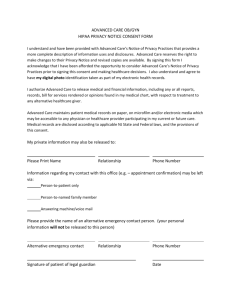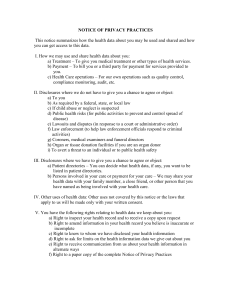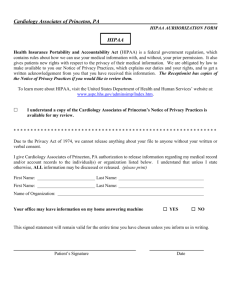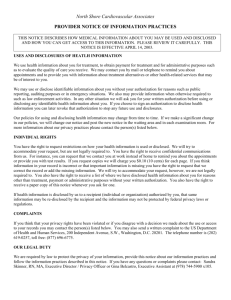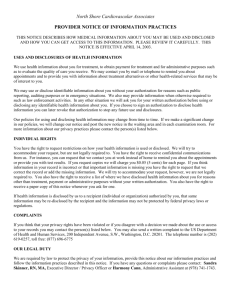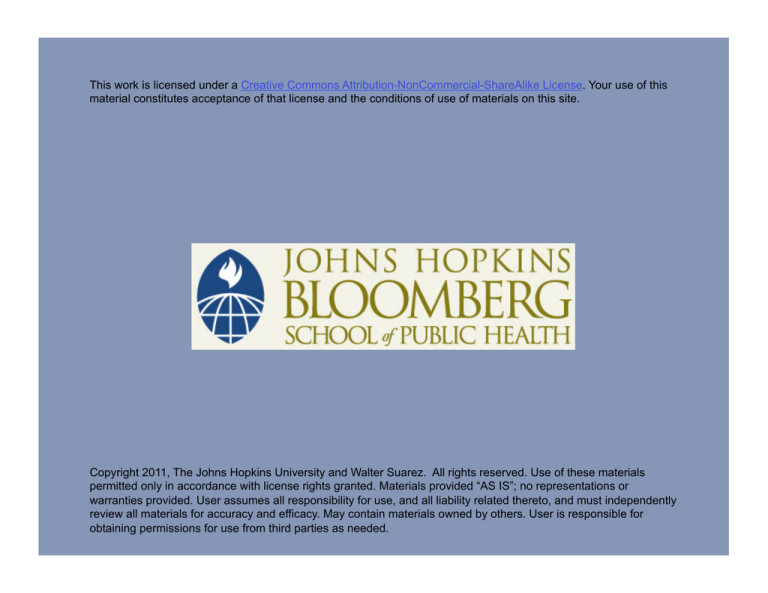
This work is licensed under a Creative Commons Attribution-NonCommercial-ShareAlike License. Your use of this
material constitutes acceptance of that license and the conditions of use of materials on this site.
Copyright 2011, The Johns Hopkins University and Walter Suarez. All rights reserved. Use of these materials
permitted only in accordance with license rights granted. Materials provided “AS IS”; no representations or
warranties provided. User assumes all responsibility for use, and all liability related thereto, and must independently
review all materials for accuracy and efficacy. May contain materials owned by others. User is responsible for
obtaining permissions for use from third parties as needed.
Section B
Health Information Privacy, Part 1
Privacy of Health Information: Current Practices
HIPAA has generally defined the floor for uses
and disclosures of health information
HIPAA did not require “consent” for uses or disclosures related to
treatment, payment, and health care operations
- “Authorization” required for other specific uses and disclosures
HIPAA does not define requirements for:
- Electronic consent
- Granularity of consumer controls
-
-
Electronic health information exchanges
Personal health records
3
Privacy of Health Information: Current Practices
HIPAA has generally defined the floor for uses
and disclosures of health information
HIPAA did not require “consent” for uses or disclosures related to
treatment, payment, and health care operations
- “Authorization” required for other specific uses and disclosures
HIPAA does not define requirements for:
- Electronic consent
- Granularity of consumer controls
-
-
Electronic health information exchanges
Personal health records
4
Privacy of Health Information: Current Practices
Other federal laws define specific use and disclosure requirements
(over and above HIPAA) for specific types of data (i.e., substance
abuse, mental health, lab data, education records)
There are also program-specific privacy protection requirements
(such as Medicare, Medicaid, SCHIP)
Many state laws establish additional requirements when privacy
consent is needed
-
-
Some even for treatment, payment, and operations
Still mostly silent about electronic consent, granularity,
electronic health information exchanges, personal health
records
Existence of a national “framework” on health information privacy
—but unenforceable
5
US Health Information Privacy and Security Framework
Developed and released in 2008
Purpose: to provide a clear,
understandable, uniform set of
principles to support a consistent
and coordinated approach to
privacy and security for organizations
to adhere to and implement
Document defines a set of principles
to serve as a guide (non-enforceable)
for public and private organizations
References to federal laws and
6
Core Principles
Individual access
- Individuals should be provided with a simple and timely means
to access and obtain their individually identifiable health
information in a readable form and format
Correction
-
Individuals should be provided with a timely means to:
Dispute the accuracy or integrity of their individually
identifiable health information
Have erroneous information corrected
Have a dispute documented if their requests are denied
7
Core Principles
Openness and transparency
- There should be openness and transparency about policies,
procedures, and technologies that directly affect individuals
and/or their individually identifiable health information
Individual choice
-
Individuals should be provided a reasonable opportunity and
capability to make informed decisions about the collection,
use, and disclosure of their individually identifiable health
information
8
Core Principles
Collection, use and disclosure limitation
- Individually identifiable health information should be collected,
used, and/or disclosed only to the extent necessary to
accomplish a specified purpose(s) and never to discriminate
inappropriately
Data quality and integrity
- Persons and entities should take reasonable steps to ensure that
individually identifiable health information is complete,
accurate, and up-to-date to the extent necessary for the
person’s or entity’s intended purposes and has not been altered
or destroyed in an unauthorized manner
9
Core Principles
Safeguards
- Individually identifiable health information should be protected
with reasonable administrative, technical, and physical
safeguards to ensure its confidentiality, integrity, and
availability and to prevent unauthorized or inappropriate
access, use, or disclosure
Accountability
- These principles should be implemented, and adherence
assured, through appropriate monitoring and other means and
methods should be in place to report and mitigate nonadherence and breaches
10
Glossary
11
Base Requirements and Principles: HIPAA Privacy Rule
Consumer controls over health information
- Rights to consumer
Boundaries of uses and disclosures
- Limitations on when, how, to whom, and for what purpose
entities can use and disclose health information
General security requirement
- Further expanded with HIPAA security rule
Accountability
- Effects for negligent or criminal actions with health information
12
Base Requirements and Principles: HIPAA Privacy Rule
Covered entity and protected health information
- Applicable only to entities covered by HIPAA
-
Applicable to all health information (used/disclosed by covered
entities)
No consent requirement
- For uses or disclosures of health information for TPO
(treatment, payment, health care operations)
-
For 22 types of uses and disclosures, including public health,
health oversight, judicial and administrative, victims of abuse
and neglect, others
-
Authorization needed for all others
No preemption of state laws that are more stringent
13
Base Requirements and Principles: HIPAA Privacy Rule
Covered entity and protected health information
- Applicable only to entities covered by HIPAA
-
Applicable to all health information (used/disclosed by covered
entities)
No consent requirement
- For uses or disclosures of health information for TPO
(treatment, payment, health care operations)
-
For 22 types of uses and disclosures, including public health,
health oversight, judicial and administrative, victims of abuse
and neglect, others
-
Authorization needed for all others
No preemption of state laws that are more stringent
14
Base Requirements and Principles: Patient Consent
Patient consent (authorization) in most states
- Required by other laws
-
For specific types of information
Under HIPAA (authorization for certain disclosures)
In specific states
Determine several factors about health information
WHO: can access, use or disclose
WHAT: information can be assessed, used, disclosed
TO WHOM: can information be disclosed
WHY: for what purpose(s)
WHEN: time-limited
15
Base Requirements and Principles: Patient Rights
Receive a notice of privacy
practices
Access individually identifiable
health information for review
and/or copy
Request amendments to health
information
Request an accounting of
certain disclosures that a
covered entity has made of
their PHI
Request privacy protections to
health information
-
Right to request
restrictions on the use and
disclosure of health
information
-
Right to request
confidential
communications from a
entities
File a complaint about privacy
issues
16
Base Requirements and Principles: Patient Rights
Receive a notice of privacy
practices
Access individually identifiable
health information for review
and/or copy
Request amendments to health
information
Request an accounting of
certain disclosures that a
covered entity has made of
their PHI
Request privacy protections to
health information
-
Right to request
restrictions on the use and
disclosure of health
information
-
Right to request
confidential
communications from a
entities
File a complaint about privacy
issues
17
Base Requirements and Principles: Organization
Organization responsibilities
- Administrative policies and procedures
-
-
-
-
Privacy officer
Apply minimum necessary requirements
Handle various types of sensitive health information
-
Mitigate harm, in the event of a use or disclosure done in
violation of privacy requirements or organization’s own policies
and procedures
Verify the identity and authority of individual requesting health
information prior to disclosure (if not known by the entity
disclosing the information), including documentation of such
identify and authority
18
American Recovery and Reinvestment Act (ARRA), 2009
Privacy provisions
- HIPAA provisions extended to business associates
-
New breach notification requirements
FCC rules: entities not covered by HIPAA
HHS rules: entities covered by HIPAA
-
Ability to restrict disclosures to a health plan for payment or
operations or items/services paid out of pocket
Limit uses and disclosures to limited data sets or minimum
necessary
-
-
Accounting of disclosures through EHRs for TPO
19
American Recovery and Reinvestment Act (ARRA), 2009
Privacy provisions
- Provide copy of personal health information in electronic format
to individual
-
-
Study and recommendations to Congress for P&S requirements
for non-covered entity PRH vendors
Enforcement
Extend HIPAA civil penalties to BAs
Provides state AGs with authority to enforce HIPAA
Employees/individuals can be criminally liable
20


